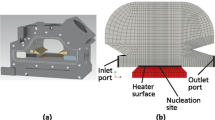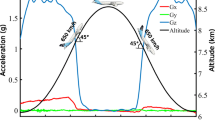Abstract
Although significant progress has been made, the mechanisms of heat transfer responsible for enhancement during nucleate boiling are not fully understood. The primary barriers to a complete understanding of the heat transfer during boiling are due to difficulties associated with performing rapid microscale measurements, ambiguity due to the interaction of previous and neighbouring bubbles, uncertainty with regard to gravitational effects and the complexity associated with theoretical modelling that often results in empiricism/adjustable parameters being introduced into the theoretical/numerical works.
In this investigation, a numerical simulation of hemispherical bubble growth on a heated surface in μ-gravity has been performed. The simulations agree well with R113 μ-gravity measurements provided by [1]. The simulations indicate that during the bubble expansion phase, the heat transfer coefficient along the boiling surface in the vicinity of the triple interface is substantial. The maximum heat transfer coefficient reaches values over 3500 W/m2K and decays with radial distance from the vapour-liquid interface. This is over 10 times larger than the effective thermal conductance due to diffusion in the undisturbed region. The increase in the local heat transfer coefficient is complimented by the fact that the effective area of enhancement around the bubble increases with bubble radius enhancing the thermal conductance of single bubble events.
Similar content being viewed by others
References
Lee, H.S., andMerte H., Jr. 1996, “Hemispherical vapour bubble growth in microgravity: Experiments and model”. Int. J. Heat Mass Transfer, 39, 2449–2461
Demiray, F., Kim, J., 2004 “Microscale heat transfer measurements during pool boiling of FC-72: Effect of subcooling”. Int. J. Heat Mass Transfer 47 (14–16), 3257–3268.
Henry, C.D., Kim, J. 2005, “Thermocapillary effects on low-g pool boiling from microheater arrays of various aspect ratio”. Microgravity Science and Technology 15 (1), 170–175.
Robinson, A.J., Judd, R.L. (2001), “Bubble growth in uniform and spatially distributed temperature field”. Int. J. Heat Mass Transfer, 44 (14), 2699–2710
Wagner, E., Sodtke, C., Schweizer, N., Stephan, P., 2006, “Experimental study of nucleate boiling heat transfer under low gravity conditions using TLCs for high resolution temperature measurements”. Heat Mass Trans., 42, 875–883
Author information
Authors and Affiliations
Corresponding author
Additional information
Paper was presented on the Second International Topical Team Workshop on TWO-PHASE SYSTEMS FOR GROUND AND SPACE APPLICATIONS October 26–28, 2007, Kyoto, Japan.
Rights and permissions
About this article
Cite this article
Robinson, A.J. Heat transfer near the contact line during boiling in microgravity. Microgravity Sci. Technol 19, 139–140 (2007). https://doi.org/10.1007/BF02915778
Received:
Revised:
Accepted:
Issue Date:
DOI: https://doi.org/10.1007/BF02915778




